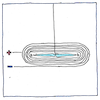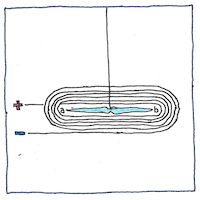Luigi Galvani,
Hans Christian Ørsted,
Johann Schweigger
electromagnetism

|
Galvanometer
Luigi Galvani discovered the frog galvanoscope by accident, studying the nerves of twitching frog legs. Galvani and his nephew Giovanni Aldini put the frog leg in a test tube and wired it up. Improvements accelerated after Hans Christian Ørsted showed that a magnetic compass is deflected by an electric current. Johann Schweigger made the first sensitive galvanometer using current in a coil of wire to deflect a magnetic needle from Earth’s magnetic field. It’s not for nothing that Schweigger named the galvanometer after Luigi Galvani.
Personal connections
Galvani knew Volta who made the first battery. Galvani’s nephew helped him develop the frog galvanoscope. Ørsted was inspired by Volta’s work. Schweigger edited the journal that published Ørsted’s paper, and published critiques of Volta’s theory on metal contact in animal electricity.
Moving the dial
You indicate an interest when your experience pushes against what you know. Your sense of the situation matches instinctual patterns, pulling you into a dance. A small number of basic faces are behind many masks. Moving toward the impulse enforces your confidence. What you know is a record of when you were not thwarted and when you fought it.



Galvanometers not only detect but measure the strength and direction of an electric current. Galvanometer mechanisms are also used in other analog meters for visualizing the outputs of other sensors.
See also in The book of science:
Readings in wikipedia: